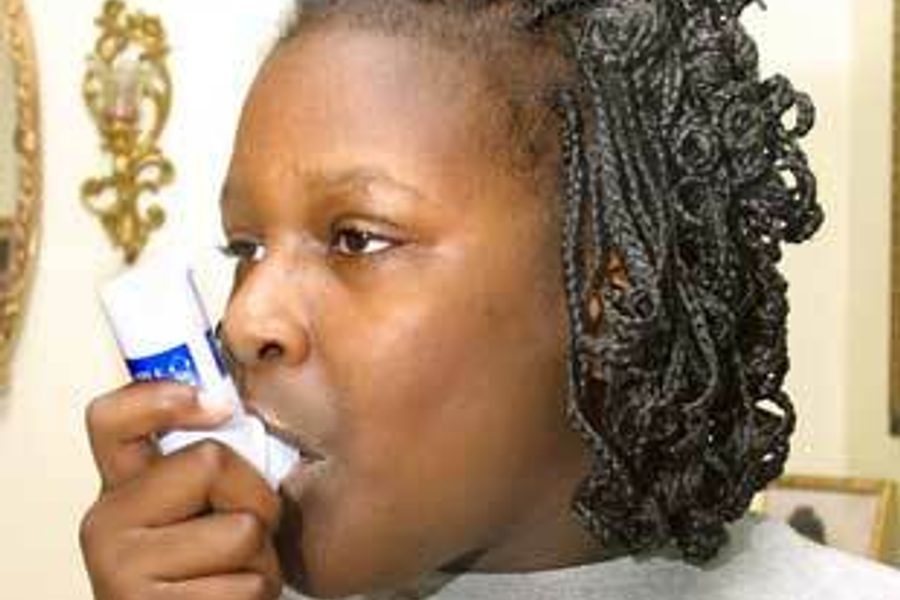Dont Breathe Easy
Experts link record rates of inner-city asthma to diminished air quality
Brian H. Kehrl

The recent discovery of record numbers of asthma sufferers in several Chicago neighborhoods has underscored what experts are calling a national asthma “epidemic.” Yet as the epidemic rages, the Bush administration has moved to relax air pollution standards for power plants, which experts have linked to the growing rates of the disease.
Asthma afflicts at least 25 million Americans and kills 5,000 people each year. Ethnic minorities and the poor comprise the vast majority of those who die or are hospitalized.
In response, researchers have developed better medications, and groups like WE ACT in Harlem and the American Lung Association (ALA) are working to understand and combat asthma. The Department of Health and Human Services, the Centers for Disease Control (CDC) and the National Institutes of Health are implementing comprehensive plans to curb asthma. Yet, cases continue to mount.
The Chicago study, conducted by the Sinai Urban Health Institute, shows that 34 percent of Puerto Rican children and 25 percent of African-American children suffer from asthma. “Finding rates like these was alarming,” says Maureen Damitz of the ALA of Chicago. “[The Sinai survey] tells us that, despite our best efforts, we still have a lot further to go.”
The findings from Chicago come one year after researchers in New York City discovered that 26 percent of children in an impoverished area of central Harlem have asthma, at that time the highest rate ever documented.
The local figures for these two cities overshadow the national rate, which has more than doubled since 1980. According to the CDC’s annual survey of child health, released on March 31, 9 million, or 12 percent of, American children have been diagnosed with asthma at some point in their lives. The most prevalent chronic childhood disease, it is a leading reason for school absences, causing 10 million missed school days every year.
The CDC survey found that black children were more than twice as likely to have been diagnosed with asthma than white children. Further, children from poor families were 40 percent more likely to have been diagnosed with the disease than those from families with incomes above the poverty line. However, the incidence of the disease may be greater since poor people lack access to the health programs that provide the diagnoses tracked by the CDC.
Experts have struggled to identify why children from ethnic minorities and poor families suffer disproportionately from asthma. They cite a possible genetic proclivity in minorities, lack of access to healthcare, higher rates of cigarette smoking among family members, and dilapidated living conditions, including inadequate ventilation and more frequent exposure to asthma triggers such as dust, mold and pests.
Yet in the last few years, some researchers have connected the asthma epidemic to high levels of air pollution from diesel engines and power plants. Both sources of pollution are found in urban areas, and both tend to be concentrated in lower-income neighborhoods.
“What can look like a racial difference is really an economic difference,” says Dr. George Thurston, a professor of environmental medicine at New York University who has testified before Congress on the links between air pollution and asthma.
Several recent studies explicitly link air pollution — exposure to ozone and the fine particulate matter produced by power plants and diesel combustion — to the aggravation of asthma symptoms. Though air pollution is not yet proved to cause asthma, Thurston and Dr. David Bates write in The Journal of the American Medical Association, “Evidence exists that air pollution may have contributed to the increasing prevalence of asthma.”
Air pollution is impossible to pinpoint as a direct cause of asthma, because air pollutants, unlike pollen and mold, do not register on the standard skin tests that determine what triggers asthma attacks in an individual. Consequently, air pollution was omitted from the common list of asthma triggers until recently.
Asthma is usually caused by multiple factors, so it is unrealistic to attribute the increased prevalence of the disease to any one cause, says Thurston. But air pollution is different from other triggers because it affects asthmatics across the board: It aggravates symptoms and makes asthma attacks more potent, regardless of specific allergies.
What’s most striking — and perhaps most disturbing — about the connection between air pollution and asthma is that pollution, unlike allergens such as household pests and dust, is the only asthma trigger that environmental regulation can control.
“We can control the indoor air quality,” says Damitz, who has two children with asthma. “I can make sure that no one smokes in my home, that we don’t have pets coming into the house, that we don’t have cockroaches, that we don’t use the wrong cleaners. Outdoor air quality is the one factor I can’t control.”
Despite mounting evidence that links asthma to air quality, the Bush administration’s Clear Skies initiative proposes to extend the deadline by which power plants must meet the EPA’s existing pollution standards. “The standards that are already not good enough would now be weakened,” says Damitz. “Which is really not going to help, especially in a city like Chicago, where we have two major power plants right where we have some of our highest prevalency rates.”
The Bush administration argues that power companies need the Clear Skies initiative to reduce the costs they will incur if forced to renovate their plants to meet existing Clean Air Act standards and timelines. Yet each year, asthma costs the country an estimated $14 billion in healthcare and lost productivity, according to the ALA.
The administration’s cost-benefit analysis has apparently determined that corporate wealth is more important than human health. Or, as the Natural Resources Defense Council puts it: “The administration’s so-called ‘Clear Skies’ bill would allow more than 100,000 additional early deaths and 2 million additional asthma attacks between now and 2020.”

I hope you found this article important. Before you leave, I want to ask you to consider supporting our work with a donation. In These Times needs readers like you to help sustain our mission. We don’t depend on—or want—corporate advertising or deep-pocketed billionaires to fund our journalism. We’re supported by you, the reader, so we can focus on covering the issues that matter most to the progressive movement without fear or compromise.
Our work isn’t hidden behind a paywall because of people like you who support our journalism. We want to keep it that way. If you value the work we do and the movements we cover, please consider donating to In These Times.




